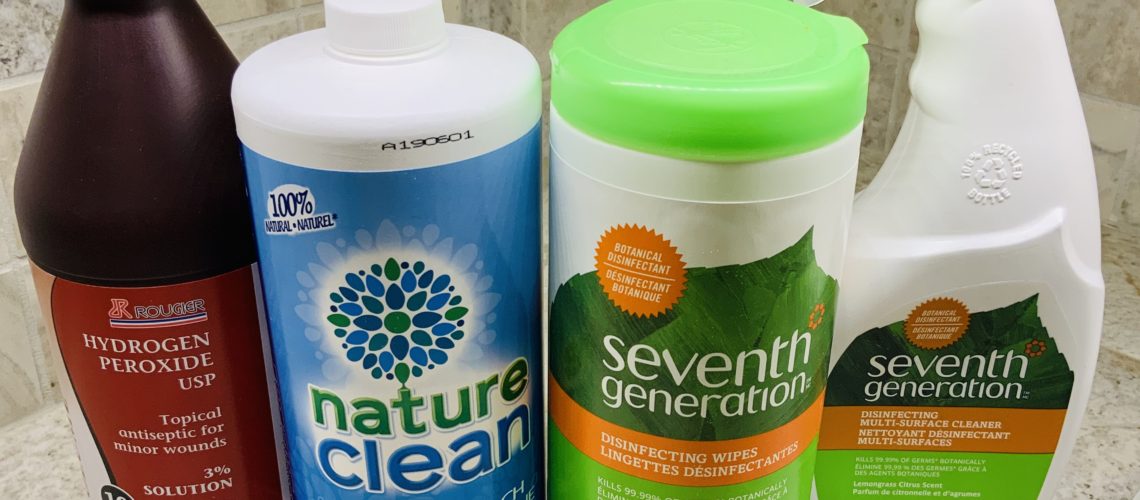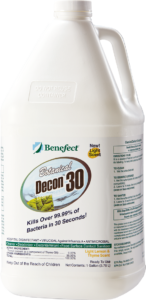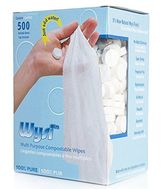Natural Disinfectants – do they work on SARS-CoV-2?

At times like these we may worry less about whether the disinfectants we use are natural. The most important concern is whether they will work on SARS-CoV-2, the virus that causes COVID-19. The good news is there are natural products that are expected to work. I say “expected” because at this time no disinfectants – natural or not – have been tested specifically on this new virus. However, many disinfectants have had prior testing that qualify them for the emerging pathogens claim. Both Health Canada and the United States Environmental Protection Agency (EPA) have lists of qualifying disinfectant products.
The EPA states:
While these products have not been tested against SARS-CoV-2, the cause of COVID-19, they are expected to be effective based on:
- Demonstrated efficacy against a harder-to-kill virus;
- Qualified for the emerging viral pathogens claim; or
- Demonstrated efficacy against another human coronavirus similar to SARS-CoV-2.
When looking over these lists many of the brands were unfamiliar to me. The ones that were familiar wouldn’t likely be sold at your local natural products store. What I did notice is that in many instances the active ingredient is hydrogen peroxide.
The National Institute of Biotechnology Information (NCBI) has published a study summary that says:
“The analysis of 22 studies reveals that human coronaviruses such as Severe Acute Respiratory Syndrome (SARS) coronavirus, Middle East Respiratory Syndrome (MERS) coronavirus or endemic human coronaviruses (HCoV) can persist on inanimate surfaces like metal, glass or plastic for up to 9 days, but can be efficiently inactivated by surface disinfection procedures with 62-71% ethanol, 0.5% hydrogen peroxide or 0.1% sodium hypochlorite within 1 minute.” – Read full page
The full study has been published at Science Direct and The Journal of Hospital Infection. Of the three disinfectants mentioned, ethanol and hydrogen peroxide are considered natural products while sodium hypochlorite (aka chlorine bleach) is not.
Hydrogen Peroxide
I was pleased to see hydrogen peroxide mentioned. It’s widely available and very safe for the environment. As it degrades it converts to oxygen and water leaving no residue behind. Drug store brands are typically 3% peroxide.
You can also find hydrogen peroxide at a 35% concentration. One brand, Sproutmaster, is a food grade product for use in sprouting. Many health food stores carry this product. Such a high concentration is of course meant to be diluted and must be handled carefully. It is very caustic so be sure to read the warning label and follow all safety precautions. Gloves and protective eyewear should also be worn. Keep highly concentrated peroxide in the refrigerator.

Another option for peroxide is non-chlorine oxygen bleach. Nature Clean is a well-known brand that makes such a product and their ingredient list says that it is “5% active”.
All the peroxide products listed here are well above 0.5%. The Sproutmaster brand has instructions for diluting down to 3%.
Despite there being a study showing that hydrogen peroxide works on coronaviruses at 0.5%, there are different opinions on whether to dilute below the standard 3%. An article on NBC’s website says it should not be diluted but didn’t but say what percentage peroxide they were referring to in the first place (though they likely meant 3%). Meanwhile an article on WebMD says that 3% peroxide can be diluted down to 0.5% to kill coronaviruses. You can read these articles for yourself and make your own decision.
Personally when I use drug store 3% peroxide and Nature Clean 5% peroxide for disinfecting surfaces I don’t dilute them. When I use Sproutmaster peroxide I dilute down to 3%. I’m only using these concentrations on ceramic tile, porcelain and enamel surfaces. Some surfaces could be damaged with a stronger peroxide so this should be factored into your decision to dilute or not.
If you choose to not dilute below 3 or 5 percent keep children and pets away from it until it dries as it is still a bit caustic at these strengths. If you choose to dilute, measure carefully to ensure your solution does not go below 0.5%.

Ethanol
The recommended strength of ethanol is a minimum of 62% according to the NCBI document. Isopropyl alcohol is an option that is usually widely available but harder to find at this time. In the case of alcohol it is important to keep it in between 62 and 71% because concentrations that are too high evaporate too quickly to disinfect. The WebMD article recommends 70%. Small batch distilleries are starting to produce high proof ethanol for making hand sanitizer and sometimes disinfectant. They are prioritizing essential service workers. If you are in need see if one in your community has some.
Ionic Silver
Health Canada’s list of qualifying products has one containing ionic silver. It is called Swish Silver Supreme. Although Eco-Logo certified, it is not a common product found in natural product stores. It is marketed to commercial and residential facilities. The active ingredients are Silver Dihydrogen Citrate (SDC) and Citric Acid. SDC “is a patented antimicrobial based on stabilized silver ion complex produced by a unique electrochemical process with silver and citric acid.” It is made by Pure Bioscience. The Environmental Working Group has evaluated the use of this ingredient in hair care products and has given it a good score.
The EPA’s list also has products with silver ion and citric acid. These are AxenR 30 and Sdc3a also referred to as Pure Hard Surface with AxenR 30 being and older formulation. They are made by Pure Bioscience. Halomist and Halospray made by Halosil are on the list and contain a proprietary blend of hydrogen peroxide and antimicrobial silver ions.
A brand I’m familiar with called Clear+Clean has been tested on various bacteria and fungi but not on viruses. So not all ionic silver products should be trusted to work on SARS-CoV-2.
What about Thymol?

Thymol is a natural disinfecting agent extracted from thyme oil. Brands that use it include Benefect, Seventh Generation and Clean Well. All these brands have products shown to work on a variety of pathogens, including viruses. They have all applied to become listed on the EPA’s emerging viral pathogen program. So far two of Benefect’s products are on the list: Benefect Botanical Daily Cleaner Disinfectant Towelette and Benefect Botanical Daily Cleaner Disinfectant Spray. They were added on March 26, 2020. I am hoping the other brands are accepted as well. Benefect is marketed more to contractors while Clean Well and Seventh Generation are available in retail outlets. Note that Clean Well is not currently available in Canada. The links below have statements from these companies about their products in relation to the new coronavirus.
Benefect – ICP Coronavirus Bulletin – information may change over time as the outbreak continues to evolve.
Seventh Generation – Coronavirus Information and Resources
Information about CleanWell® products and Novel Coronavirus
Disinfecting Tips
Before disinfecting a surface you should first scrub away dirt and debris. Then, ensure the whole surface is moistened with the disinfectant and leave on for the recommended time before wiping down. If using pre-moistened wipes make sure the wipe doesn’t start drying out before you are done. Change to a new wipe before that happens.
Wysi Wipes

Wysi Wipes are dry wipes that look like mints. They have no additives and are compostable. Once moistened they expand and can be rolled out into a wipe. You can keep them in your purse with a little bottle of disinfectant which will be easier than carrying around paper towels. If you are using peroxide for this purpose and don’t want to bring gloves with you, it might be better to use a 0.5% solution. Ethanol would be a great option to use with Wysi Wipes.
As of writing this Wysi Wipes are sadly not available due to stock shortages. Hopefully they will be available again soon. They are a great product when you are on the go. Check out their COVID-19 notice for updates. Only go out if you have to and remember to to keep a six foot social distance.
Final Thoughts
My personal preference would be to use hydrogen peroxide. It is cost effective, especially if being diluted down to 0.5%. It is odourless and leaves no residue behind. We know it is likely to work based on the study summary published on NCBI. When I started working on this post none of the thymol products were on the EPA’s list and I am happy to see Benefect become accepted. The others shouldn’t be too far behind. I will post updates in the comments section.
Stay healthy, stay safe! 🍏 🇨🇦 ❤️
References
List of hard-surface disinfectants for use against coronavirus (COVID-19) (Health Canada)
List N: Disinfectants for Use Against SARS-CoV-2 (United States EPA)
Sproutmaster Information Sheet (Sproutmaster)
Many common household cleaning products can kill the coronavirus if you use them properly (NBC News)
The Most Effective Ways to Kill Coronavirus in Your Home (WebMD)
Hair Styling Aide Products Containing Silver Dihydrogen Citrate (Environmental Working Group)
Silver Dihydrogen Citrate (Pure Bioscience)
Update on Seventh Generation:
So in a previous comment I was incorrect about Seventh Generation having different EPA numbers than Clean-Well and Benefect. They are all the same. I must have been looking at the wrong number on the bottle. The following is a blurb from their coronavirus info page:
Through a long and close partnership with CleanWell®, Seventh Generation Disinfecting Cleaners, Wipes and Sprays utilize the active ingredient Thymol, which is the active ingredient in CleanWell® proprietary formulations. CleanWell® is now included on the EPA list. Therefore, our products are EPA registered broad spectrum disinfectants which have demonstrated effectiveness against viruses similar to the 2019 novel coronavirus, SARS-CoV-2, the cause of COVID-19, on hard, nonporous surfaces.
https://www.seventhgeneration.com/blog/coronavirus-information-and-resources
Hi again folks,
I found two other thymol products on the EPA’s list:
Thymox Disinfectant Spray made by Laboratorie M2
https://thymox.com/products/household/
Ready to Use Thymol made by Wexford Labs Inc
https://www.wexfordinnovations.com/products/ready-to-use-thymo-cide/
Note – on the website above they call it “Thymocide”.
I was visiting Clean Well’s Information sheet on the Novel Coronavirus and they say their products are now on the EPA’s list. In fact they say their EPA product numbers are the same as Benefect’s (which the EPA lists as being made by Clean Well LLC). So they are the same company – different brands. Seventh Generation’s products are still not on the list. Their products say “Clean Well inside” . . . but I don’t see the EPA number. So my guess is that Clean Well supplies the active ingredients and Seventh Generation uses that in a slightly different formulation. I will post here in the comments as I discover new information.
One note I’d like to add here in the comments. The study quoted in my post mentions hydrogen peroxide as effective in the summary but not in the conclusions. I have contacted the journal to ask why and am waiting to hear back. I will update here when I hear from them. I am still confident in recommending hydrogen peroxide based on it being an active ingredient in several products on both Health Canada’s and the EPA’s lists. As well it is mentioned in articles by NBC and WebMD.